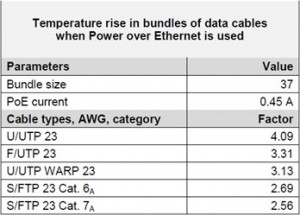WARP, an unshielded data cable designed with foil segments, to protect against data interference from adjacent cables
WARP beats conventional unshielded cables and makes longer links possible
R&M, the global Swiss developer and provider of cabling systems for top-quality network infrastructures, has done in-depth investigations of the heat-up of network cables in connection with Power over Ethernet (PoE). The test shows that the Cat.6A U/UTP WARP cables developed by R&M dissipate heat more effectively than conventional unshielded cables.
“WARP cables stay cool and behave just as well as shielded cables. That is an advantage when you are planning a local data network intended to include Power over Ethernet,” says Matthias Gerber, Market Manager LAN Cabling at R&M.
In big installations with massive cable bundles and PoE operation, a WARP cable becomes less hot than conventional unshielded U/UTP cables and the link is therefore allowed to be correspondingly longer.
Trend toward Power over Ethernet requires a different type of planning
Power over Ethernet (PoE) – that is, supplying power to terminal equipment over data cables – is increasingly popular. The advantages of using PoE are obvious: The power supplied to the device does not have to be separately fed over a power cable and an unwieldy power supply unit or from a battery. Instead, the device draws its energy over the data network. To this end, current has to be fed into the data line in addition to the data signal at a central point, namely in the network distributor.
IEEE, the standards organization, is currently working on markedly increasing the transmittable power supplied. The new 4PPoE protocol will make available two new levels of power: 55 W (level 3) and 90 to 100 W (level 4). Up to one ampere is supposed to flow over each twisted pair. This approach opens up new applications such as the operation of high-powered WLAN antennas and monitoring cameras. However, the higher current level poses new challenges for data cabling.
Wherever more current is flowing, there will be more heat due to resistance. Warmer cables attenuate data transmission to a greater extent than before. As a result, there may not be enough signal reaching the receiver, thereby making data transmission impossible. This effect must be taken into account when new PoE-compatible LAN cabling is planned. The maximum transmission distance must be adjusted to temperature conditions and shortened.
Shielding helps dissipate heat from cable bundles
The relevant draft standards ISO/IEC TR 29125 and Cenelec EN 50174-99-1 already describe the cable bundle temperature rise to be expected from the use of 4PPoE. A distinction is made between two heat fractions:
A bundle heating up from the inside to the outside
The entire cable bundle heating up from the outside up to the ambient temperature.
The second fraction depends largely on the installation conditions of the cable bundle. The first, the temperature rise within the cable bundle, depends solely on how the cable is constructed. In a typical U/UTP cable, the PoE-related heat-up rises by a factor of 5 whereas in a shielded cable it ranges from a factor of 2.5 to 3 depending on the design.
That means in a cable bundle consisting of U/UTP cables, the temperature rises by 2 times as much as in a comparable bundle consisting of S/FTP cables. The reason is that in shielded cables the metal in the shield helps to transport the heat from within the bundle to the outside.
WARP cables with ANEXT foil behave like shielded cables
Although the R&M Cat.6A WARP cables are categorized as unshielded UTP cables, their jacket contains a special foil to reduce data interference from adjacent cables (Alien NEXT). These short metal foil segments (wave reduction pattern, WARP) suppress Alien NEXT, but do not have to be grounded, which saves on installation costs.
Matthias Gerber added, “With an R&M WARP cable, you have not only the ideal solution for Alien NEXT but also decisive advantages for the use of PoE. Under certain circumstances, the temperature difference and the longer link can decide whether a specific installation functions or not.”
The thermal measurements on PoE test set-ups showed that the Cat.6A WARP cables behaved just the same as shielded F/UTP cables. Whereas a normal U/UTP cable of the same diameter can be expected to heat up by a factor of around 5, the R&M WARP cable can be assumed to heat up by a factor of 3, similar to a shielded cable.
Installations featuring regular commercial U/UTP Cat.6A cables and R&M WARP Cat.6A cables can be simulated with the PoE calculator from R&M. This tool can be employed to calculate the anticipated temperatures in a cable bundle and from that, the maximum length of a cabling link.
With small cable bundles, the difference between the cable types has only a minimal effect. In large installations involving massive cable bundles, a WARP cable can become as much as 14° C less hot. The link is allowed to be as much as 11% longer.
The PoE calculator is available at the http://tinyurl.com/zhj3d2r. In the White Paper “4PPoE – Parameters for Network Planning,” R&M provides information on the physical backgrounds. Network planners and installers can consult this document for practical instructions on how to prepare the cabling to meet 4PPoE requirements. The White Paper is available at www.rdm.com.




